This is a long post, so buckle up.
Arkansas’ 21-19 loss to Liberty risks becoming a watershed moment in the Sam Pittman era. It causes the 2022 season to officially become a disappointment. It provides evidence that while Pittman was the perfect coach to bring the Hogs out of the SEC cellar, he may have already hit his ceiling. The Hogs gave Pittman a big contract last offseason, so he’s going to get a chance to figure it out. If Sam Pittman 1.0 has gone as far as he can go, we discussed on Sunday what Sam Pittman 2.0 will have to do to take the Hogs to next level.
For today, let’s dive into Arkansas’ utter offensive collapse against the Liberty Flames.
Advanced Stats
Confused by any of the advanced stats you see here? Be sure to check out the glossary.

This game ended up as a defensive slugfest, with both teams recording negative Scrimmage EPA (meaning: both offenses performed worse than the average FBS team). I’m a little surprised that Liberty ended up with only minus-0.4 Special Teams EPA given that they had a punt blocked for a safety, though their punt coverage was excellent all other times (that played a role, as we’ll see).

On a high level, Arkansas’ offense was doomed by two things: negative plays and field position. The Hogs had terrible starting field position all game and then had a bunch of negative plays that killed drives before they could ever get going.
For the defense, you might be tempted to call this a good performance by the defense, given that the Hogs allowed a season-low 321 yards.. I’m not going that far. Liberty’s offense came in 83rd in PPA/drive and 83rd in EPA/play, making it the worst the Hogs have faced this season; possibly even worse than Missouri State’s. Also: note field position. Liberty had fewer yards because it needed fewer yards.
Liberty’s first touchdown came on a 59-yard drive after a punt was partially blocked. Their second touchdown came on a 51-yard drive after the Hogs foolishly decided to go for it on 4th-and-6 at midfield and failed. Their third touchdown came on an 80-yard drive after Trey Knox bobbled a touchdown pass into the hands of a Liberty defender. And that was it. That’s all the points Liberty needed.

Arkansas came in 13th in the nation in leverage rate, sitting at well over 70%. But the Hogs were atrocious on early downs, falling behind due to an avalanche of negative plays. This was the most off-schedule I’ve seen the Hogs be under Pittman/Briles.
What did Liberty do to stop Arkansas’ offense?
Let’s start here: Arkansas was clearly unmotivated and unprepared, and as a result they played an uncharacteristically bad game. We discussed that at the beginning of the post. That absolutely played a factor. As did the fact that KJ Jefferson was, apparently, injured. This section will focus on what Liberty did schematically to disrupt the Hogs. Because it may not be as simple as it looked on the field.
Coverage
We’ll begin with coverage. Recall this from the preview (emphasis added):
Liberty wants to play a lot of man…
Facing Arkansas’ offense isn’t fun for any defense, because you have to pick your poison. Zone allows you to get more defenders into the box to stop the run, but KJ Jefferson has been shredding zone, especially in the last few games. That’s one of the reasons why the Hogs have come out throwing on early downs recently. If Liberty tries zone, expect the Hogs to be more aggressive through the air.
But if you play man, while you can force Jefferson to make throws he’s less comfortable with (slants, in particular), it’s much harder to stack the box. Against South Carolina’s man-heavy defense, the Hogs simply ran it down their throats and barely needed to pass.
KJ Jefferson’s struggles against man coverage are well-known at this point. There are several factors: he’s not accurate when targeting receivers moving east and west (slants, crosses, posts, etc). He also does not read how his receivers will break against man defenders very well. He struggles to get through progressions and locks onto his primary target, missing receivers and occasionally holding onto the ball too long.
Liberty was almost exclusively man in this game, and Jefferson never looked comfortable. He routinely missed wide open receivers and was inaccurate on crossing routes over the middle, which is where man coverage should be attacked. He was sacked four times, but all four were coverage sacks, as he held onto the ball too long while searching for a receiver.
But how did Liberty stop the run?
Of course, if Liberty was in man, then we know they weren’t stacking the box. I expected the Flames to play man and the Hogs to just run over them, like in the South Carolina game. That… didn’t happen. Arkansas instead had its worst rushing performance of the season.
Let’s go back to the preview, talking about Liberty’s outside linebackers:
Those edge guys are really dangerous against read plays. Their objective is to disrupt everything the offense is trying to do
Liberty used a 3-3-5 defense but aligned two outside linebackers to sandwich the defensive line, forming a bit of a 3-4/5-2 look. The edge guys – an outside linebacker and a standup defensive end – were the key to everything Liberty was trying to do.
Let’s walk through the chess match between the Arkansas offense and the Liberty defense.
Phase 1 – Twisting and scraping
In their film study for this game, Liberty’s staff picked up on a couple of tendencies in Arkansas’ run game:
- Arkansas likes to run zone plays to the tight end side
- Arkansas likes to run Counter, but not the full power series (Power O is normally a complement run to Counter)
Liberty also guessed that Arkansas’ offensive line would not handle twisting very well, as both tackles – Luke Jones and Dalton Wagner – are not overly mobile. Their gameplan was incredibly simple: twist to the closed (tight end) side, and scrape to the open side.
Here’s what it looked like:

The Hogs have called an outside zone read. The weakside defensive end is left unblocked as the “read” man (Jefferson can keep and run left if he loses outside leverage), while all of the linemen plus Trey Knox at tight end are blocking to the right.
Liberty is scraping on the back end – Liberty knew Arkansas would read to the open side – so that linebacker is “filling in” the gap created when the end crashes inside. On the “closed” side, the Flames are twisting. The outside linebacker is knifing inside, hoping to draw a block from Wagner (#78), which frees the defensive end to come around Wagner and make the play.
Arkansas does not handle the twist well:
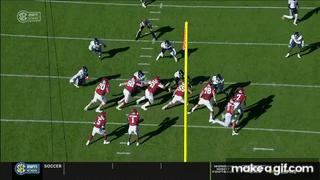
You may notice in the above gif that Sanders actually has a large cutback lane to his left that he doesn’t see. When the Hogs put AJ Green in the game, he saw it immediately:
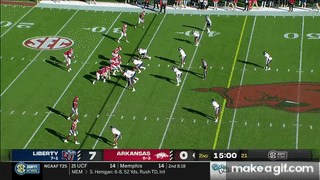
Green finished with six carries for 56 yards and four successes. Why he had just six carries, I have no idea.
The Hogs also tried G Counter, a run that has been very effective over the last couple of games:

H-back Hudson Henry and left guard Brady Latham are going to pull and lead to the right side. Liberty is twisting to Henry’s side – treating him as the tight end.
For this twist, the defensive end (inside man) is going to crash outside, attempting to draw multiple blockers. Both Jones and Ricky Stromberg end up trying to block him, freeing the outside linebacker to blow up the play:
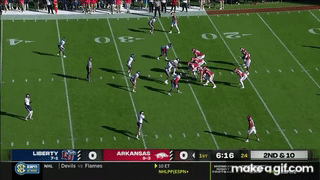
Notice that the two plays we’ve shown so far have opposite twists. Against the outside zone, Liberty brought the inside man around the edge rusher, while on this play, the edge rusher goes around the inside man. Both were perfect for what Arkansas was running. So there are only three explanations: one, Liberty was really lucky and guessed right; two, Arkansas has been tipping what they are running based on formation and running back alignment; or three, Liberty knew Arkansas’ play calls. My guess is two, but three isn’t out of the question, given that Arkansas doesn’t huddle so someone could theoretically figure out terminology and hand signals.
Now sufficiently terrified of the twist, the Hogs tried in the second quarter to overwhelm it, calling a GT Counter:

Now both Wagner and Beaux Limmer are pulling from the open side and leading into the tight end side. The Hogs are going to get five blockers against two defenders on the twist side.
Of course, pulling both linemen from the open side leaves no one to block the backside end, who can be aggressive because the Flames are scraping (the linebacker behind him will take his edge responsibility):
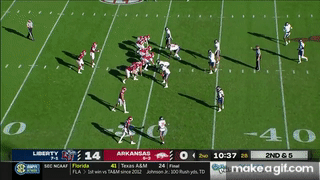
This was a read play, but Jefferson couldn’t keep because the scraping linebacker set the edge. So he had to hand off on a doomed play. This was the first really bad play call I saw, because the Hogs should have known this wouldn’t work.
Phase 2 – The Hogs adjust
After six scoreless drives, the Hogs had cycled through just about all of their base run plays, only to find that Liberty’s twist-and-scrape strategy was an effective counter for all of it. Ideally, the Hogs would simply be able to block the twists, given that they are playing LIBERTY, but Kendal Briles, Cody Kennedy, and Sam Pittman apparently decided that the Hogs simply couldn’t block it. After the midway point of the second quarter, the Hogs ran no more Counters and only a couple of zones to the tight end side.
That knocks about 80% of the run game out. With six minutes left in the second quarter, the Hogs tried something Liberty wasn’t prepared for:

This is an inside zone, but the Hogs have aligned Sanders and the tight end (Knox) to the same side. They don’t do this often. The run direction is away from the twist and to the weak side, where Liberty’s linebackers have too much space to cover effectively:
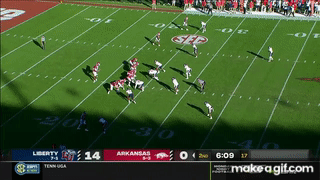
The next play is identical and gains nine yards. Then the Hogs – still running tempo because they’ve cracked Liberty’s code – now have Trey Knox split out with two other receivers in a bunch formation. Because there’s no tight end, the Flames don’t twist, but their linebackers overplay the strong side. Once again, weak inside zone pays off:
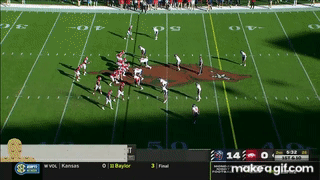
Those three plays provided 50 of Sanders’ 60 rushing yards and all three successes. His other 14 carries netted 10 yards with no success.
Unfortunately for the Hogs, the next play was the pass to Knox in the endzone that he bobbled into a defender’s hands for an interception.
Phase 3 – Both sides adjust
Down 21-3 at the break, the Hogs didn’t have a ton of time to establish the run in the second half. Briles’ adjustment was to stop using a tight end so the Flames would stop with the dang twists. The first run of the second half was a six-yard run on an inside zone with no tight end.
After getting an initial first down, the Hogs call some kind of midline/bash read and discover that Liberty is prepared for it:

This play is a little suspect to me because it really looks like Liberty knew what was coming. This is the only time I saw the Flames twist their two interior linemen, and the Flames execution of this twist – the underneath lineman takes Sanders, while the twisting lineman takes Jefferson – seems almost too perfect:
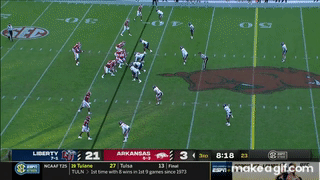
Getting the ball back down 21-5, the Hogs tried something new. On 2nd-and-9, the Hogs line up with no tight end but motion Knox into a wing tight end position. That signals to Liberty to twist, so Jefferson just grabs the snap and runs around it:
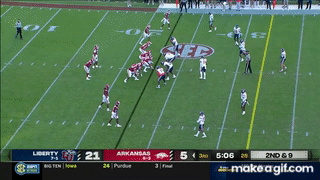
As fun as that was, the Hogs were deep in the playbook… and rapidly running out of time. The Hogs were running plays they hadn’t practiced very much. What was a scheme issue in the first half became an execution issue in the second.
In the plays that follows that one, the Hogs had two false starts and a direct snap to Rashod Dubinion fail because half of the line didn’t know the snap count and didn’t start to block until way after the snap.
Phase 4 – Hogs abandon the run
Arkansas’ final two touchdown drives featured almost no called runs, as the Hogs had to give up on that. There was some clever stuff: the Hogs brought Green in motion and gave it to him on a jet sweep that gained 13 yards, mostly thanks to an uncalled hold on Knox. The final called run of the game was a 10-yard by Green on another weak inside zone.
But ultimately, a very simple tactic by Liberty forced Arkansas to abandon almost all of its vaunted run game. The Hogs were so terrified of the twists that they had to dig deep into the playbook to find anything that worked. Arkansas’ offensive line got into its own head, which caused execution issues, like this snap before anyone on the offense was ready:

That’s just embarrassing. Credit Liberty for coming up with the perfect gameplan and executing it, but to watch the Hogs just fall apart like that is pitiful.
Postgame autopsy
So what do we say about this?
That interception was every bit as impactful as it seemed. Knox dropping a touchdown into the defender’s hands really flipped the tide in this game. I think had the Hogs cut it to 14-7 there, they probably would have won this game easily. By that point, the Hogs knew what Liberty was doing and had found some things that worked. The defense was starting to tighten up. And a 14-7 deficit meant the Hogs wouldn’t have to scramble. Instead, by the time they got the ball back, they were down 21-0 and forced to rely on an injured quarterback having to go right into the teeth of a pretty good man defense.
Arkansas’ run game has some design flaws. Simply put: it should not be that easy to negate all of Arkansas’ base run game with some simple twists. Arkansas either needed to be able to block those, or if not, have a better set of complements that the line is prepared to execute. The Hogs chunked a bunch of their playbook in a panic and spent more than half the game trying to be creative.
Arkansas’ offense has to start faster. Slow starts have been a feature of the offense this year, as Kendal Briles likes to use the first couple of drives to evaluate the defense’s strategy. Inside zone has been Arkansas’ best run all season, but the Hogs seem hesitant to use it early in games due to an apparently-strong desire to run on the edge. I get it – winning the edge really opens everything up for the offense – but not immediately going to your best play puts you at risk of falling behind. The Hogs didn’t commit to inside zone until they were down 14-0, and after that, game circumstances (the interception, a two-minute drill, and then the clock in the second half) prevented them from ever fully committing to it, even though they were gashing the Flames.
Thanks for reading! Be sure to follow us on Twitter.
The latest from Fayette Villains, straight to your inbox
Enter your email to subscribe and receive new post alerts and other updates. You can unsubscribe at any time.